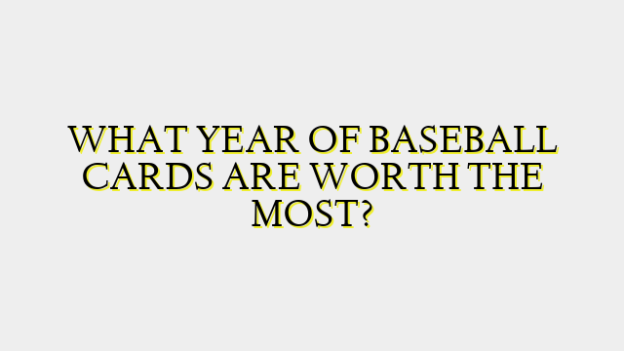When it comes to determining the most valuable baseball cards, there are a few key factors that collectors and experts look at. The year of issue, the players featured, and the condition and scarcity of the cards all play a major role. Generally speaking, the oldest baseball cards tend to be the most desirable since they were produced in smaller numbers and have had more time to gain appreciation as collectible artifacts. Condition is absolutely vital, as even the rarest and most historic cards lose much of their value if they are worn, bent, or damaged in any way.
Some of the earliest and most valuable baseball card years include:
1909 to 1911 T206 tobacco cards: This iconic set features numerous all-time great players in their baseball primes. Superstars like Ty Cobb, Cy Young, and Walter Johnson are hugely popular with collectors. High grade examples of their cards can fetch six figures or more at auction. Even common players in good condition still sell for thousands due to the age of these cards.
1912 and 1914 Cracker Jack cards: Early promotional issues given out in Cracker Jack boxes. Extremely scarce, especially in nice condition. Honus Wagner’s appearance in the 1909-11 T206 set makes his card the most expensive trading card in existence, but the rarity of the Cracker Jack issues also drives their value very high.
1915 Cracker Jack cards: Considered the rarest set issued during the pre-war era. Production was very small. Collectors pay large sums for any card from this year in solid shape.
1930 Goudey Baseball Gum cards: Introduced color lithography techniques that made the photos and designs pop. Features many Hall of Famers from the 1920s and 1930s. High grade examples of Babe Ruth, Lou Gehrig, and Jimmie Foxx can bring five figures or more.
Moving into the post-World War II era, several other notable card years emerge that maintain strong collector demand:
1952 Topps: Generally recognized as the first “modern” design that paved the way for Topps’s long run as the sport’s premier issuer. Mickey Mantle rookie card is arguably the most iconic in the hobby. High grade ones sell for over $1 million.
1957 Topps: Generally considered the most attractive design of the 1950s issues with its solid colors and painted player portraits. The post-war boom of interest in baseball trading cards was in full swing.
1959 Topps: Last year of the classic colorful designs before shifting to black and whites. Final appearance of many Stars from the 1940s and 1950s.
1964 Topps: First color photograph cards. Precious since it captures players right before the cultural changes of the 1960s. Final rookie cards of Yankee dynasty stars like Mickey Mantle and Whitey Ford.
1968 Topps: Large change to brighter, fun designs with whimsical backs. Considered the apex of classic 1960s sets before radical shifts in the 1970s. Huge surge in interest due to nostalgia factor now.
1972 Topps: Final year before the switch from gum to wax wrappers. LastCards of superstars like Hank Aaron, Roberto Clemente, and Willie Mays before retirement.
1975 Topps: Epic rookie season for George Brett, Robin Yount, Fred Lynn so their cards are highly sought. Marked a period of transition after Mantle/Mays retired.
1976 SGC: Final season before introduction of modern stats on fronts. Features rookie cards of Donruss superstars Andre Dawson and Dale Murphy.
As you can see, factors like player appearance, design changes, cultural context, and scarcity all influence which years hold special importance in the eyes of avid baseball card collectors. While condition is critical for all issues, the older the cards are, the less surviving examples exist in pristine shape, driving values ever upward for these pioneering tobacco and gum-era relics of baseball’s history. Understanding the significance placed on high-profile rookie seasons and final veteran appearances further informs why certain yearly releases remain sharply sought after to this day.


